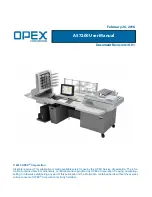
12
Introduction
AS7200 User Manual - OPEX Corporation
Structured vs. Unstructured jobs
Structured jobs require you to scan documents in a particular order. For
example, when running a structured job, the machine may prompt you to scan
a batch ticket first, then a stub, then a check, and/or another document, and
finally an envelope to signify the end of the transaction. If a page type is
scanned out of sequence or if the system is expecting a certain page type, the
system will alert you.
In an unstructured job, you can scan any of the expected page types in any
sequence. The only restriction is that the transaction boundary, in most cases
an envelope, is scanned last in the transaction. The transaction boundary tells
the system the current transaction is complete and the next transaction will
begin.
Page types
The term “page type” is used to specify a collection of criteria that a piece must
meet to be classified as a certain type of document: in other words, length,
height, barcode, mark detect, MICR, etc. The system uses the page type
parameters set up by your System Administrator to classify documents that
come into the system. When the scanner processes documents in a job, it
gathers data (such as length and width) on each item and compares the item to
the page types you have designated for that job. This is how the system
identifies each document scanned into the system. The system then collects
the appropriate data from the document and sorts it according to the current
job parameters.













































